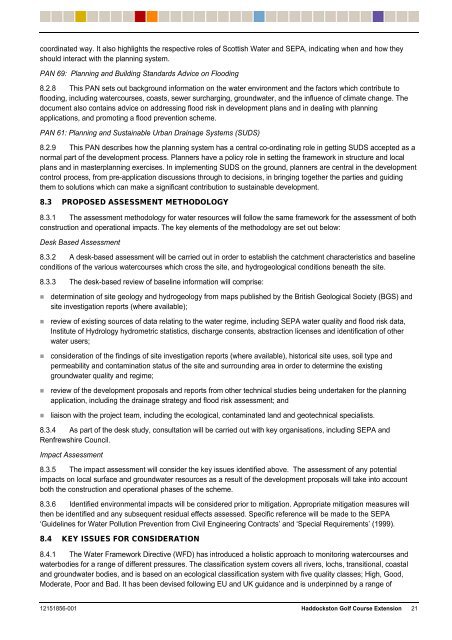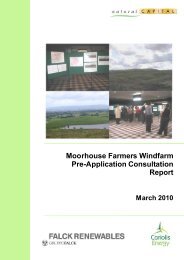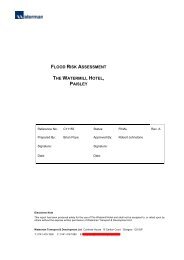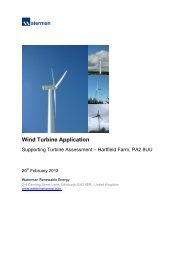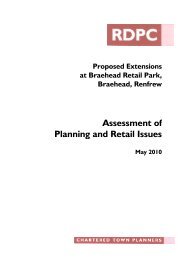Haddockston Golf Course Extension EIA Scoping Report
Haddockston Golf Course Extension EIA Scoping Report
Haddockston Golf Course Extension EIA Scoping Report
You also want an ePaper? Increase the reach of your titles
YUMPU automatically turns print PDFs into web optimized ePapers that Google loves.
coordinated way. It also highlights the respective roles of Scottish Water and SEPA, indicating when and how they<br />
should interact with the planning system.<br />
PAN 69: Planning and Building Standards Advice on Flooding<br />
8.2.8 This PAN sets out background information on the water environment and the factors which contribute to<br />
flooding, including watercourses, coasts, sewer surcharging, groundwater, and the influence of climate change. The<br />
document also contains advice on addressing flood risk in development plans and in dealing with planning<br />
applications, and promoting a flood prevention scheme.<br />
PAN 61: Planning and Sustainable Urban Drainage Systems (SUDS)<br />
8.2.9 This PAN describes how the planning system has a central co-ordinating role in getting SUDS accepted as a<br />
normal part of the development process. Planners have a policy role in setting the framework in structure and local<br />
plans and in masterplanning exercises. In implementing SUDS on the ground, planners are central in the development<br />
control process, from pre-application discussions through to decisions, in bringing together the parties and guiding<br />
them to solutions which can make a significant contribution to sustainable development.<br />
8.3 PROPOSED ASSESSMENT METHODOLOGY<br />
8.3.1 The assessment methodology for water resources will follow the same framework for the assessment of both<br />
construction and operational impacts. The key elements of the methodology are set out below:<br />
Desk Based Assessment<br />
8.3.2 A desk-based assessment will be carried out in order to establish the catchment characteristics and baseline<br />
conditions of the various watercourses which cross the site, and hydrogeological conditions beneath the site.<br />
8.3.3 The desk-based review of baseline information will comprise:<br />
determination of site geology and hydrogeology from maps published by the British Geological Society (BGS) and<br />
site investigation reports (where available);<br />
review of existing sources of data relating to the water regime, including SEPA water quality and flood risk data,<br />
Institute of Hydrology hydrometric statistics, discharge consents, abstraction licenses and identification of other<br />
water users;<br />
consideration of the findings of site investigation reports (where available), historical site uses, soil type and<br />
permeability and contamination status of the site and surrounding area in order to determine the existing<br />
groundwater quality and regime;<br />
review of the development proposals and reports from other technical studies being undertaken for the planning<br />
application, including the drainage strategy and flood risk assessment; and<br />
liaison with the project team, including the ecological, contaminated land and geotechnical specialists.<br />
8.3.4 As part of the desk study, consultation will be carried out with key organisations, including SEPA and<br />
Renfrewshire Council.<br />
Impact Assessment<br />
8.3.5 The impact assessment will consider the key issues identified above. The assessment of any potential<br />
impacts on local surface and groundwater resources as a result of the development proposals will take into account<br />
both the construction and operational phases of the scheme.<br />
8.3.6 Identified environmental impacts will be considered prior to mitigation. Appropriate mitigation measures will<br />
then be identified and any subsequent residual effects assessed. Specific reference will be made to the SEPA<br />
‘Guidelines for Water Pollution Prevention from Civil Engineering Contracts’ and ‘Special Requirements’ (1999).<br />
8.4 KEY ISSUES FOR CONSIDERATION<br />
8.4.1 The Water Framework Directive (WFD) has introduced a holistic approach to monitoring watercourses and<br />
waterbodies for a range of different pressures. The classification system covers all rivers, lochs, transitional, coastal<br />
and groundwater bodies, and is based on an ecological classification system with five quality classes; High, Good,<br />
Moderate, Poor and Bad. It has been devised following EU and UK guidance and is underpinned by a range of<br />
12151856-001 <strong>Haddockston</strong> <strong>Golf</strong> <strong>Course</strong> <strong>Extension</strong> 21


